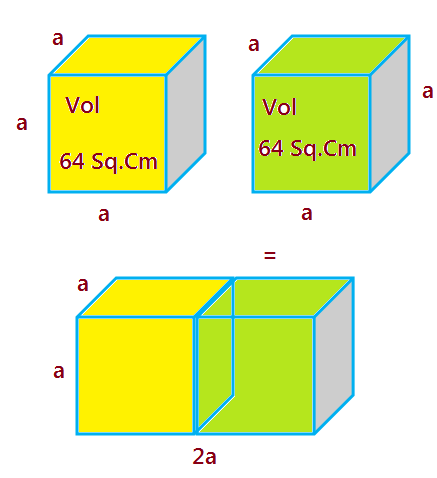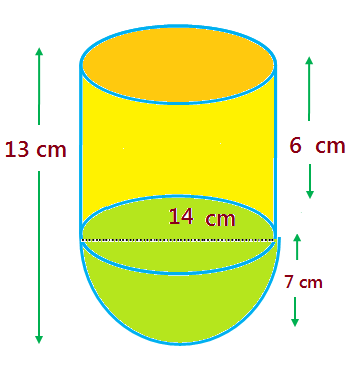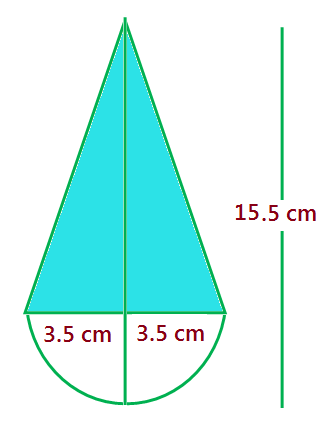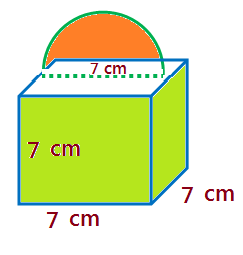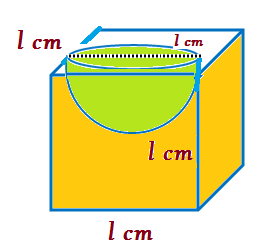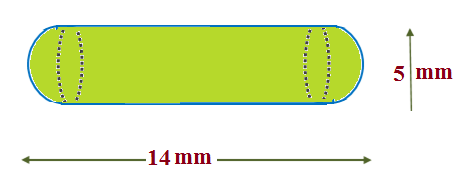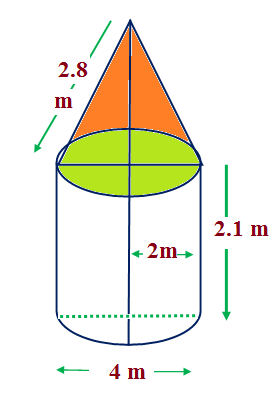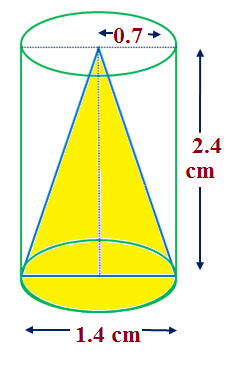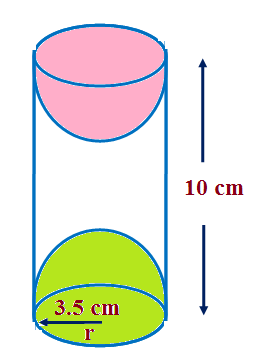2 cubes each of volume 64 cm3 are joined end to end. Find the surface area of the resulting cuboid.
Solution :
It is given that : Volume of one cube = 64 cm3 .
We know that, Volume of a cube = a3
(Here 'a' is the Side of cube)
⇒ $a^3 $ = 64
⇒ a = 4 cm.
So, the side length of each cube is 4 cm.
Now these two cubes when joined, it can be observed that, their lengths are added and breadth and height remains the same.
Surface Area of Cuboid
Length of Cuboid = a + a = 2a = 8 cm
And Breadth = a = 4 cm , Height = a = 4 cm.
Surface Area of the cuboid = SA = 2(lb + bh + lh)
$$ = 2(8 × 4 + 4 × 4 + 8 × 4) $$
$$ = 2(32 + 16 + 32) $$
$$ = 2(80) $$
$$ SA = 160 .cm^2 $$
The surface area of the resulting cuboid is = 160 cm2 .
A vessel is in the form of a hollow hemisphere mounted by a hollow cylinder. The diameter of the hemisphere is 14 cm and the total height of the vessel is 13 cm. Find the inner surface area of the vessel.
Solution :
It is given that : diameter of hemisphere = 14 cm.
The radius (r) of the hemisphere is half the diameter: 14 cm/2 = 7 cm.
The radius of the cylinder is the same as the radius of the hemisphere, since the cylinder is mounted on it. So, The Radius of hallow cylindrical portion = 7 cm .
The height of the hemisphere is equal to its radius, which is 7 cm.
The height (h) of the cylinder is the total height of the vessel minus the height of the hemisphere: 13 cm− 7 cm = 6 cm.
Curved Surface Area (CSA) of the Hemisphere:
$$ ⇒ {2{\pi}rh } $$
$$⇒ {2× {22 \over 7 }× 7 × 6 } $$
$$⇒ { 44 × 6 } $$
$$⇒ { 264 } $$
Curved Surface Area (CSA) of the Hemisphere:
$$ {2{\pi}r^2 } $$
$$⇒ {2 × {22 \over 7 }× (7)^2 } $$
$$⇒ {2 × 22 × 7 } $$
$$⇒ {308 } $$
Inner surface area of the vessel = Curved surface area of cylinder + Curved surface area of hemisphere.
$$⇒ { 264 } + {308 } $$
$$⇒ 572 cm^2$$
Hence, Inner Surface Area of Vessel = 572 cm2 .
A toy is in the form of a cone of radius 3.5 cm mounted on a hemisphere of same radius. The total height of the toy is 15.5 cm. Find the total surface area of the toy.
Solution :
It is given that : Radius of cone = 3.5 cm
It can be observed that the radius of the conical part and the hemispherical part is same
∴ Radius of the hemispherical portion , = 3.5 cm
And The height of the hemisphere is equal to its radius, which is 3.5 cm.
The height (h) of the cone is the total height of the toy minus the height of the hemisphere:
= 15.5 - 3.5 = 12 cm.
To find the curved surface area of the cone, you need its slant height (l)
Now, Slant height of cone (l)can be calculated as follows :
( For conical part 'l' is the slant height and 'h' is the height of cone and 'r' is the radius of base )
l = $\sqrt { r^2 + h^2 }$
= $\sqrt { (3.5)^2 + 12^2 }$
= $\sqrt { 12.25 + 144 }$
= $\sqrt { 156.25 }$
l = 12.5 cm.
Curved Surface Area (CSA) of the Hemisphere:
$$ {2{\pi}r^2 } $$
$$⇒ ( {2 × {22 \over 7 }× (3.5)^2 }) $$
$$⇒ {2 × {22 \over 7 }× 12.25 } $$
$$⇒ { 2× 22 × 1.75 } $$
$$⇒ {77 cm^2 } $$
Curved surface area of cone:
$$ {{\pi}rl } $$
$$⇒ { {22 \over 7 }× 3.5 × 12.5 } $$
$$⇒ {22 × 0.5 × 12.5 } $$
$$⇒ {11 × 12.5} $$
$$⇒ {137.5 cm^2 } $$
Now, Total surface area of toy can be calculated as follows:
= Curved surface area of hemisphere + Curved surface area of cone.
$$⇒ 77 + 137.5 $$
$$⇒ 214.5 cm^2 $$
Hence, Total surface area of toy = 214.5 cm2 .
A cubical block of side 7 cm is surmounted by a hemisphere. What is the greatest diameter the hemisphere can have? Find the surface area of the solid.
Solution :
For the hemisphere to be surmounted on the cubical block, its diameter must be less than or equal to the side length of the cube.
The greatest possible diameter is therefore equal to the side of the cube, which is 7 cm.
∴ Radius of the hemispherical portion , 7/2 cm = 3.5 cm
Here base of hemisphere falls on cube , so that area should not from part of solid .
( The total surface area of the solid is the sum of the surface area of the cube and the curved surface area of the hemisphere, minus the area of the base of the hemisphere that is on the cube's top face. )
Now, Surface Area of Solid :
= Surface Area of Cube + Curved Surface Area of hemisphere – Surface Area of Base of Hemisphere
( Surface area of Cubical block = 6 × Side2)
( Curved surface area of hemisphere = ${2{\pi}r^2 }$)
( Area of Base of Hemisphere = ${{\pi}r^2 }$)
$$⇒ 6a^2+ {2{\pi}r^2 } - {{\pi}r^2 } $$
$$⇒ 6a^2+ {{\pi} r^2 } $$
$$⇒ 6 ×(7)^2 + {{22 \over 7 }×(3.5)^2 } $$
$$⇒ 6 × 49 + {{22 \over 7 }× 3.5 × 3.5} $$
$$⇒ 294 + {22 × 3.5 × 0.5} $$
$$⇒ 294 + 38.5 $$
$$⇒ 332.5 cm^2 $$
Hence, Total surface area of Solid = 332.5 cm2 .
A hemispherical depression is cut out from one face of a cubical wooden block such that the diameter l of the hemisphere is equal to the edge of the cube. Determine the surface area of the remaining solid.
Solution :
It is given that the diameter of the hemisphere is equal to the edge length of the cube thus greatest (maximum) diameter of the hemisphere = side of the cube = l
∴ Radius of the hemispherical portion = l/2
( The total surface area of the remaining solid is found by taking the surface area of the cube, adding the curved surface area of the hemispherical depression, and subtracting the area of the circular top of the depression.)
Now, Surface Area of Solid can be calculated as follows :
= Surface Area of Cube + Curved Surface Area of hemisphere – Surface Area of Base of Hemisphere
( Surface area of Cubical block = 6 × Side2)
( Curved surface area of hemisphere = ${2{\pi}r^2 }$)
( Area of Base of Hemisphere = ${{\pi}r^2 }$)
$$⇒ 6l^2+ {2{\pi}r^2 } - {{\pi}r^2 } $$
$$⇒ 6l^2+ {{\pi} r^2 } $$
$$⇒ 6l^2 + ({{\pi}×({l \over 2 })^2 } ) $$
$$⇒ 6l^2 + ({{\pi}× {l^2 \over 4 }}) $$
$$⇒ {24l^2 \over 4 } + ({{\pi}× {l^2 \over 4 }}) $$
( Taking Common )
$$⇒ {l^2 \over 4 }( 24 + {\pi}) $$
Hence, Total surface area of Solid = ${l^2 \over 4 }( 24 + {\pi}) $ unit2 .
A medicine capsule is in the shape of a cylinder with two hemispheres stuck to each of its ends (see Fig). The length of the entire capsule is 14 ‘ mm and the diameter of the capsule is 5 mm. Find its surface area.
Solution :
It is given that : The diameter of the capsule is 5 mm.
∴ The radius (r) of the hemispheres and the cylinder is half the diameter: 5 mm/2 = 2.5 mm.
The length of each hemisphere is equal to its radius, which is 2.5 mm
Now, Length of cylindrical portion (h) :
= Length of the entire capsule - 2(radius of hemisphere)
= 14 - $ (2 × {5 \over 2 })$ = 9 mm.
Curved Surface Area (CSA) of the two Hemispheres:
$$ 2 × {2{\pi}r^2 } $$
( Curved surface area of hemisphere = ${2{\pi}r^2 }$)
$$⇒ 2 × {2× {22 \over 7 }× ({5 \over 2 })^2 } $$
$$⇒ { 4 × {22 \over 7 }× 6.25 } $$
$$⇒ { 78.57 mm^2 } $$
Curved Surface Area (CSA) of the Cylinder:
$$ {2{\pi}rh } $$
( Curved surface area of cylinder =${2{\pi}rh }$ )
$$⇒ {2× {22 \over 7 }× {5 \over 2 } × 9 } $$
$$⇒ {{22 \over 7 }× 22.5 } $$
$$⇒ 141.43 mm^2 $$
Surface area of the capsule = Curved surface area of cylinder + Curved surface area of 2 hemisphere.
$$⇒ {141.43 } + 78.57 $$
$$⇒ 220 mm^2$$
Hence, Total surface area of capsule = 220 mm2 .
A tent is in the shape of a cylinder surmounted by a conical top. If the height and diameter of the cylindrical part are 2.1 m and 4 m respectively, and the slant height of the top is 2.8 m, find the area of the canvas used for making the tent. Also, find the cost of the canvas of the tent at the rate of Rs 500 per m2. (Note that the base of the tent will not be covered with canvas)
Solution :
The canvas for the tent covers the curved surface area of the cylindrical part and the curved surface area of the conical part. The base of the tent is not covered.
It is given that : diameter of cylindrical portion = 4 m.
∴ Radius of the cylindrical part , r = 4/2 m = 2 m.
The height (h) of the cylinder is 2.1 m.
And, The slant height (l) of the cone is given as 2.8 m.
The radius (r) of the cone is the same as the cylinder, so r = 2 m.
Curved Surface Area (CSA) of the Cone:
$$ {{\pi}rl } $$
( Curved surface area of cone = ${{\pi}rl } $)
$$⇒ { {22 \over 7 } × 2 × 2.8 } $$
$$⇒ {22 × 2 × 0.4 } $$
$$⇒ { 17.6 m^2 } $$
Curved Surface Area (CSA) of the Cylinder:
$$ {2{\pi}rh } $$
( Curved surface area of cylinder =${2{\pi}rh }$ )
$$⇒ {2× {22 \over 7 }× 2 × 2.1 } $$
$$⇒ {2 × 22 × 2× 0.3} $$
$$⇒ 26.4 m^2 $$
Now, Total area of the canvas can be calculated as follows:
= Curved surface area of cylindrical portion + Curved Surface Area of conical portion .
$$⇒ {26.4 } + 17.6 $$
$$⇒ 44 m^2 $$
Hence, Total area of the canvas = 44 m2 .
The rate of the canvas is Rs 500 per square meter.
Total cost of canvas used = Total area of the canvas × Rate per meter
$⇒ 44 × 500$
$⇒ 22000 Rs.$
Therefore, it will cost Rs. 22000 for making such a tent.
From a solid cylinder whose height is 2.4 cm and diameter 1.4 cm, a conical cavity of the same height and same diameter is hollowed out. Find the total surface area of the remaining solid to the nearest cm2.
Solution :
The remaining solid consists of a cylinder with a cone-shaped cavity. To find the total surface area, you need to add the curved surface area of the cylinder, the area of the cylindrical base, and the curved surface area of the cone-shaped cavity.
It is given that : The height (h) of the cylinder is 2.4 cm.
The diameter of the cylinder is 1.4 cm.
∴ The radius (r) of the cylinder and the cone is half the diameter: 1.4 cm/2 = 0.7 cm.
And The height (h) of the cone is the same as the cylinder, so h= 2.4 cm.
To find the curved surface area of the cone, you need its slant height (l)
Now, Slant height of cone (l)can be calculated as follows :
( For conical part 'l' is the slant height and 'h' is the height of cone and 'r' is the radius of base )
l = $\sqrt { r^2 + h^2 }$
= $\sqrt { (0.7)^2 + (2.4)^2 }$
= $\sqrt { 0.49 +5.76 }$
= $\sqrt { 6.25 }$
l = 2.5 cm.
Slant height of cone = 2.5 cm
Curved surface area of cone:
$$ {{\pi}rl } $$
$$⇒ { {22 \over 7 }× 0.7 × 2.5 } $$
$$⇒ {22 × 0.1 × 2.5 } $$
$$⇒ {5.5 cm^2 } $$
Curved Surface Area (CSA) of the cylinder:
$$ {2{\pi}rh } $$
$$⇒ {2 × {22 \over 7 }× 0.7 × 2.4} $$
$$⇒ {2 × 22 × 0.1 × 2.4} $$
$$⇒ { 10.56 cm^2 } $$
Area of the cylindrical base:
$$ {{\pi}r^2 } $$
$$⇒ ( { {22 \over 7 }× (0.7)^2 }) $$
$$⇒ {22 × 0.07 } $$
$$⇒ { 1.54 cm^2 } $$
Now, Total surface area of the remaining solid can be calculated as follows:
= Curved surface area of cylindrical portion + Curved Surface Area of conical portion + Area of cylindrical base .
$$⇒ {10.56 + 5.5 + 1.54 }$$
$$⇒ 17.6 cm^2 $$
Rounding to the nearest whole number, the total surface area is 18 cm2
A wooden article was made by scooping out a hemisphere from each end of a solid cylinder, as shown in Figure . If the height of the cylinder is 10 cm, and its base is of radius 3.5 cm, find the total surface area of the article.
Solution :
It is given that : Radius of the hemispherical part = 3.5 cm.
And Height of cylindrical portion = 10 cm.
It can be observed that the radius of the cylindrical part and the hemispherical part is same
Radius of cylindrical portion = 3.5 cm.
Curved Surface Area (CSA) of the two Hemispheres:
$$ 2 × {2{\pi}r^2 } $$
( Curved surface area of hemisphere = ${2{\pi}r^2 }$)
$$⇒ 2× { 2× {22 \over 7 }× (3.5)^2 } $$
$$⇒ {4 × {22 \over 7 }× 12.25 } $$
$$⇒ { 4 × 22 × 1.75 } $$
$$⇒ { 154 } cm^2 $$
Curved Surface Area (CSA) of the Cylinder:
$$ {2{\pi}rh } $$
( Curved surface area of cylinder =${2{\pi}rh }$ )
$$⇒ { 2× {22 \over 7 }× 3.5 × 10 } $$
$$⇒ {2 × 22 × 0.5 × 10 } $$
$$⇒ 220 cm^2 $$
Total surface area of the article = Curved surface area of cylinder + Curved surface area of 2 hemisphere.
$$⇒ 220 + 154 $$
$$⇒ 374 cm^2$$
Hence, Total surface area of article = 374 cm2 .
Syllabus for class 10
Advanced courses and exam preparation.
Previous Year Paper
Advanced courses and exam preparation.
Mock Test
Explore programming, data science, and AI.
